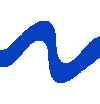Forces on Submerged Surfaces in Static Fluids
We have seen the following features of statics fluids
- Hydrostatic vertical pressure distribution
- Pressures at any equal depths in a continuous fluid are equal
- Pressure at a point acts equally in all directions (Pascal's law).
- Forces from a fluid on a boundary acts at right angles to that boundary.
Objectives:
We will use these to analyse and obtain expressions for the forces on submerged surfaces. In doing this it should also be clear the difference between:
- Pressure which is a scalar quantity whose value is equal in all directions and,
- Force, which is a vector quantity having both magnitude and direction.
1. Fluid pressure on a surface
Pressure is defined as force per unit area. If a
pressure p acts on a small area  then the force exerted on that area will be
then the force exerted on that area will be

Since the fluid is at rest the force will act at right-angles to the surface.
General submerged plane
Consider the plane surface shown in the figure below. The total area is made up of many elemental areas. The force on each elemental area is always normal to the surface but, in general, each force is of different magnitude as the pressure usually varies.

We can find the total or resultant force, R, on the plane by summing up all of the forces on the small elements i.e.

This resultant force will act through the centre of pressure, hence we can say
If the surface is a plane the force
can be represented by one single resultant force,
acting at right-angles to the plane through the centre of pressure.
Horizontal submerged plane
For a horizontal plane submerged in a liquid (or a plane experiencing uniform pressure over its surface), the pressure, p, will be equal at all points of the surface. Thus the resultant force will be given by

Curved submerged surface
If the surface is curved, each elemental force will
be a different magnitude and in different direction but still
normal to the surface of that element. The resultant force can
be found by resolving all forces into orthogonal co-ordinate directions
to obtain its magnitude and direction. This will always be
less than the sum of the individual forces, .
.
2. Resultant Force and Centre of Pressure on a submerged plane surface in a liquid.
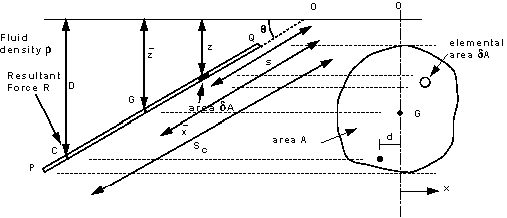
This plane surface is totally submerged in a liquid
of density  and inclined at an angle of
and inclined at an angle of
 to the horizontal. Taking pressure as
zero at the surface and measuring down from the surface, the pressure
on an element
to the horizontal. Taking pressure as
zero at the surface and measuring down from the surface, the pressure
on an element  , submerged a distance
z, is given by
, submerged a distance
z, is given by

and therefore the force on the element is

The resultant force can be found by summing all of these forces i.e.

(assuming  and g as
constant).
and g as
constant).
The term  is known as the
1st Moment of Area of the plane PQ about
the free surface. It is equal to
is known as the
1st Moment of Area of the plane PQ about
the free surface. It is equal to  i.e.
i.e.
where A is the area of the plane and  is
the depth (distance from the free surface) to the centroid, G.
This can also be written in terms of distance from point O ( as
is
the depth (distance from the free surface) to the centroid, G.
This can also be written in terms of distance from point O ( as
 )
)

Thus:
The resultant force on a plane

This resultant force acts at right angles to the
plane through the centre of pressure, C, at a depth D. The moment
of R about any point will be equal to the sum of the moments
of the forces on all the elements  of
the plane about the same point. We use this to find the position
of the centre of pressure.
of
the plane about the same point. We use this to find the position
of the centre of pressure.
It is convenient to take moments about the point where a projection of the plane passes through the surface, point O in the figure.

We can calculate the force on each elemental area:

And the moment of this force is:

 are the same for each element,
so the total moment is
are the same for each element,
so the total moment is

We know the resultant force from above  ,
which acts through the centre of pressure at C, so
,
which acts through the centre of pressure at C, so

Equating gives,

Thus the position of the centre of pressure along the plane measure from the point O is:

It look a rather difficult formula to calculate -
particularly the summation term. Fortunately this term is known
as the 2nd Moment of Area ,  ,
of the plane about the axis through O and it can be easily calculated
for many common shapes. So, we know:
,
of the plane about the axis through O and it can be easily calculated
for many common shapes. So, we know:

And as we have also seen that  1st
Moment of area about a line through O,
1st
Moment of area about a line through O,
Thus the position of the centre of pressure along the plane measure from the point O is:

and depth to the centre of pressure is

How do you calculate the 2nd moment of area?
To calculate the 2nd moment of area of a plane about an axis through O, we use the parallel axis theorem together with values of the 2nd moment of area about an axis though the centroid of the shape obtained from tables of geometric properties.
The parallel axis theorem can be written

where  is the 2nd
moment of area about an axis though the centroid G of the plane.
is the 2nd
moment of area about an axis though the centroid G of the plane.
Using this we get the following expressions for the position of the centre of pressure

(In the examination the parallel axis theorem and
the  will be given)
will be given)
The second moment of area of some common shapes.
The table blow given some examples of the 2nd
moment of area about a line through the centroid of some common
shapes.
| Shape | Area A | 2nd moment of area,  , about
an axis through the centroid , about
an axis through the centroid
|
Rectangle
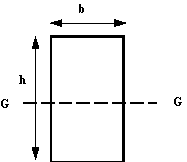 |
 |

|
| Triangle
|
 |

|
| Circle
| 
| 
|
| Semicircle
|
 |

|
Lateral position of Centre of Pressure
If the shape is symmetrical the centre of pressure lies on the line of symmetry. But if it is not symmetrical its position must be found by taking moments about the line OG in the same way as we took moments along the line through O, i.e.

but we have  so
so

3. Submerged vertical surface - Pressure diagrams
For vertical walls of constant width it is usually much easier to find the resultant force and centre of pressure. This is done graphically by means of a pressure diagram.
Consider the tank in the diagram below having vertical
walls and holding a liquid of density  to a depth of H. To the right can be seen a graphical representation
of the (gauge) pressure change with depth on one of the vertical
walls. Pressure increases from zero at the surface linearly by
to a depth of H. To the right can be seen a graphical representation
of the (gauge) pressure change with depth on one of the vertical
walls. Pressure increases from zero at the surface linearly by
 , to a maximum at the base of
, to a maximum at the base of  .
.
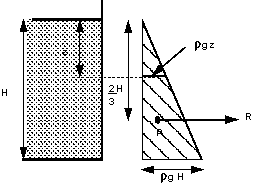
Pressure diagram for vertical wall.
The area of this triangle represents the resultant force per unit width on the vertical wall, using SI units this would have units of Newtons per metre. So
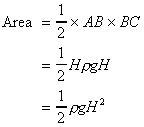
Resultant force per unit width

The force acts through the centroid of the pressure
diagram. For a triangle the centroid is at 2/3 its height, i.e.
in the figure above the resultant force acts horizontally through
the point  .
.
For a vertical plane the depth to the centre of pressure is given by

This can be checked against the previous method:
The resultant force is given by:
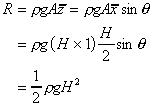
and the depth to the centre of pressure by:

and by the parallel axis theorem (with width of 1)
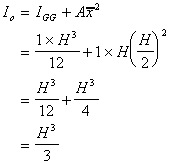
Giving depth to the centre of pressure

These two results are identical to the pressure diagram method.
The same pressure diagram technique can be used when combinations of liquids are held in tanks (e.g. oil floating on water) with position of action found by taking moments of the individual resultant forces for each fluid. Look at the examples to examine this area further.
More complex pressure diagrams can be draw for non-rectangular or non-vertical planes but it is usually far easier to use the moments method.
4. Resultant force on a submerged curved surface
As stated above, if the surface is curved the forces on each element of the surface will not be parallel and must be combined using some vectorial method.
It is most straightforward to calculate the horizontal and vertical components and combine these to obtain the resultant force and its direction. (This can also be done for all three dimensions, but here we will only look at one vertical plane).
In the diagram below the liquid is resting on top of a curved base.
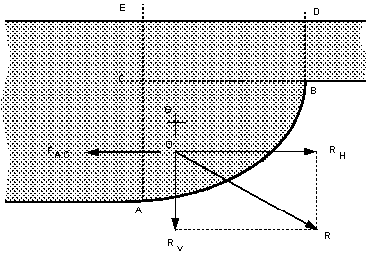
The element of fluid ABC is equilibrium (as the fluid is at rest).
Horizontal forces
Considering the horizontal forces, none can act on CB as there are no shear forces in a static fluid so the forces would act on the faces AC and AB as shown below.
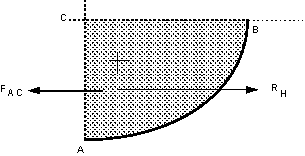
We can see that the horizontal force on AC,  ,
must equal and be in the opposite direction to the resultant force
,
must equal and be in the opposite direction to the resultant force
 on the curved surface.
on the curved surface.
As AC is the projection of the curved surface AB onto a vertical plane, we can generalise this to say
The resultant horizontal force of a fluid above a curved surface is:
RH = Resultant force on the projection of the curved surface onto a vertical plane.
We know that the force on a vertical plane must act
horizontally (as it acts normal to the plane) and that  must act through the same point. So we can say
must act through the same point. So we can say
RH
acts horizontally through the centre of pressure of the projection
of
the curved surface onto an vertical plane.
Thus we can use the pressure diagram method to calculate the position and magnitude of the resultant horizontal force on a two dimensional curved surface.
Vertical forces
The diagram below shows the vertical forces which act on the element of fluid above the curved surface.
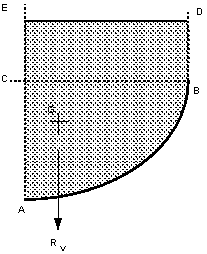
There are no shear force on the vertical edges, so the vertical component can only be due to the weight of the fluid. So we can say
The resultant vertical force of a fluid above a curved surface is:
RV = Weight of fluid directly above the curved surface.
and it will act vertically downward through the centre of gravity of the mass of fluid.
Resultant force
The overall resultant force is found by combining the vertical and horizontal components vectorialy,
Resultant force

And acts through O at an angle of  .
.
The angle the resultant force makes to the horizontal is

The position of O is the point of integration of
the horizontal line of action of  and
the vertical line of action of
and
the vertical line of action of  .
.
What are the forces if the fluid is below the curved surface? This situation may occur or a curved sluice gate for example. The figure below shows a situation where there is a curved surface which is experiencing fluid pressure from below.
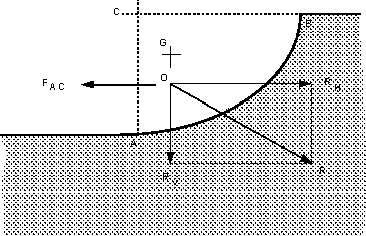
The calculation of the forces acting from the fluid below is very similar to when the fluid is above.
Horizontal force
From the figure below we can see the only two horizontal forces on the area of fluid, which is in equilibrium, are the horizontal reaction force which is equal and in the opposite direction to the pressure force on the vertical plane A'B. The resultant horizontal force, RH acts as shown in the diagram. Thus we can say:
The resultant horizontal force of a fluid below a curved surface is:

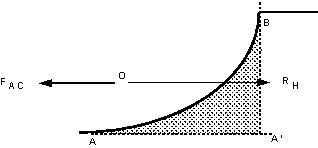
Vertical force
The vertical force are acting are as shown on the figure below. If the curved surface were removed and the area it were replaced by the fluid, the whole system would be in equilibrium. Thus the force required by the curved surface to maintain equilibrium is equal to that force which the fluid above the surface would exert - i.e. the weight of the fluid.

Thus we can say:
The resultant vertical force of a fluid below a curved surface is:
Rv =Weight of the imaginary volume of fluid vertically above the curved surface.
The resultant force and direction of application are calculated in the same way as for fluids above the surface:
Resultant force

And acts through O at an angle of  .
.
The angle the resultant force makes to the horizontal is

